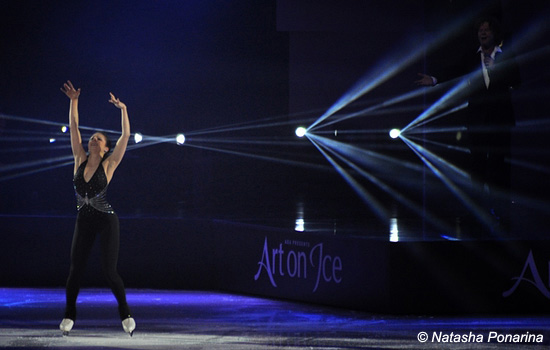"Art on Ice" and those who are behind it
March 4, 2012
By Reut Golinsky
Photo © Natasha Ponarina, Reut Golinsky
Just a few weeks after "Art on Ice" was successfully held in Lausanne, dates for winter 2013 are announced. "Art on Ice Zurich and Lausanne 2012 are now a thing of the past," is written on the official site. "Six shows in Zurich and two in the French-speaking part of Switzerland were sold out. We would like to thank all of those who experienced these events for their trust and their loyalty. The fantastic turnouts are our true compensation. Likewise your enjoyment gives us the motivation to create a completely new production for 2013."
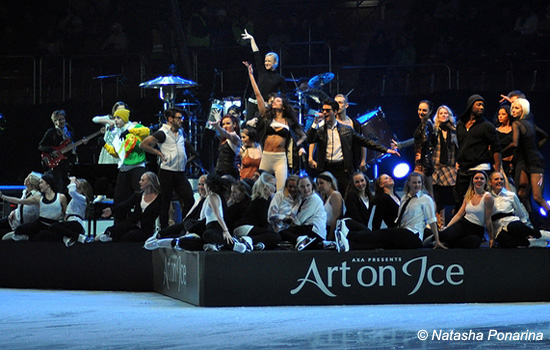
Back in 1995 hardly anyone could believe that "Art on Ice" would become such success story. Even its creators, Reto Cavaziel and Oliver Höner, were not absolutely convinced. They were 26 and 29 years old; one from the media industry, the other an eleven-time Swiss national champion.
"I wanted to make figure skating more popular in my country", says Oliver Höner, CEO of Art on Ice Production. "Back then we didn't have any big shows, only small shows of figure skating clubs. So I decided to do something for the sport and started with just a figure skating show. A year later I wanted to move to the biggest arena in Switzerland and for that I had to create a new idea to draw the attention of more people, not only the figure skating audience but much more than that. Right now, I think, the figure skating audience takes 10%, and 90% is the audience who wants to be entertained. These are people who like the figure skating, which is still the most important element in the show, but do not really follow it. I think we do something important, because we build a new audience for our sport."

Ingo Steuer, famous coach of three-time World champions Aljona Savchenko and Robin Szolkowy, is one of the veterans. He was one of the skating stars who joined this show from the very beginning and later he brought there his students, Aljona and Robin, and not only:
I started to work with "Art on Ice" at the very beginning of this show, we (he and his partner Mandy Wötzel - ed) took part in the very first show in Küsnacht and since then there were not so many shows I've missed. The show gains importance, it's getting bigger and bigger, and this gives me such a nice feeling to see it. I think it's the best show - in Europe, for sure, and I think it is one of the best we have in the world. I always thought how to "get higher" each year, always tried to make something new. They always get good music. It brings additional pressure to find the right choreography for it but until now everything works well, I'm happy.
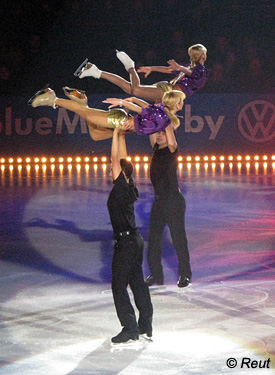 There were a few "group numbers" you created too; for example, the synchronized program for two pairs in 2009 or "James Bond" in 2010.
There were a few "group numbers" you created too; for example, the synchronized program for two pairs in 2009 or "James Bond" in 2010.
Yes, in 2009 I created a number with two couples. And I even had to skate in it myself because Stanislav was injured at that time, it was hard for me but it went well. A year after that I tried to do a little story about James Bond. It was performed by David Garrett. I've got a few different pieces of music from Oliver (Höner) and I chose that one for Tanja (Volosozhar) and Stanislav (Morozov). I asked Oliver if we could also invite to the show Anaïs (Morand) and Antoine (Dorsaz) and we decided that they can do an "intro" for Tanja and Stas. Eventually it wasn't an intro but more like a story: Antoine was James Bond and Stanislav was a bad guy who died in the end. It was a little story, it was nice to see, fun for the audience, and also it was good for Antoine and Anaïs to be a part of the show.
People mostly know Salomé Brunner for her work with Swiss single skaters, Stéphane Lambiel and Sarah Meier, but she also stands behind all the group numbers of the show and has worked within "Art on Ice" for many years.
Salomé, what is your vision for "Art on Ice"? For example, how do you think it will look like in ten years?
 Good question. I cannot tell you; usually I'm not a person who has this kind of vision. I admire Oliver (Höner) that he has this in him, and Marvin (A. Smith), the dance choreographer. They know "Oh, this has to be like this and I see it like this". And then what I can do really well is to follow, add and adjust, to make things look more beautiful maybe. So usually I take it year by year.
Good question. I cannot tell you; usually I'm not a person who has this kind of vision. I admire Oliver (Höner) that he has this in him, and Marvin (A. Smith), the dance choreographer. They know "Oh, this has to be like this and I see it like this". And then what I can do really well is to follow, add and adjust, to make things look more beautiful maybe. So usually I take it year by year.
But do you see yourself still working with "Art on Ice"?
I see that. I have no problem with that thought. I would like that.
Apart from skaters this show has many non-skating artists: acrobats, dancers, musicians. Don't you think it's too much?
I don't think you can say just that these four things are too much. I think it depends on the composition. If it's well-composed, if everything melts together, then it's right.
From my experience, to watch this show only once is not enough. When I watched it a second and third time, I suddenly noticed new things.
Agree... I had a similar feeling during the opening ceremony in Vancouver. They had this huge stage, and when I was looking at something, something else was happening on the other side. Probably such production is better for TV. On TV you can see everything. But when you're sitting down beside the ice, in the stadium, then it's impossible to see everything at once.
Marvin A. Smith whom Salomé Brunner has mentioned works with "Art on Ice" since 2008. He is one of the most successful choreographers and dance teachers in Germany and US. And since his involvement in "Art on Ice" productions he also choreographed programs for skaters like Sarah Meier and Kiira Korpi:
 It was my management, my agent who brought it up to me. I'm not sure how exactly the initial contact happened, but it was brought to my attention if I would like to work with ice skaters. So in the beginning I thought "What are you talking about?" I didn't know anything about skating other than what I saw on TV, so I thought: "You must have contacted the wrong Marvin! Maybe there is another Marvin?" or something like that. But then I said: "OK, I'm open to try". And I came and I tried.
It was my management, my agent who brought it up to me. I'm not sure how exactly the initial contact happened, but it was brought to my attention if I would like to work with ice skaters. So in the beginning I thought "What are you talking about?" I didn't know anything about skating other than what I saw on TV, so I thought: "You must have contacted the wrong Marvin! Maybe there is another Marvin?" or something like that. But then I said: "OK, I'm open to try". And I came and I tried.
First Oliver and I met several times and he was trying to explain the show to me. And everything just wasn't clicking... Because when someone is telling you something your mind works only as far as it can work, you just don't get it, you really need to see it. I was thinking: "OK, ice, stage, show", but then you get there and you realize that the ice is a football field long! Or at least seems to be so. I won't ever forget the first rehearsal I saw. We went into the venue, and that year Cortes (Garðar Thór Cortes - ed.) was singing, so he was rehearsing and they were setting the lights, and Shizuka was skating, and it was simply spectacular! It was really a breathtaking moment for me.
"Art on Ice" has dancers, singers, skaters. Don't you think it's too much maybe? It's hard to choose where to look.
I think that depends on the individual. For example, when you go to dinner, if you have a plate you're not going to have just a steak. You will have a steak, rice, you might have peas, vegetables; you might have a salad. It depends on how you eat. If you want a plate full of salad then go to a salad bar, if you want just a steak then order just a steak, but most people don't eat like that, they don't eat just one type of food, they prefer to have a colourful plate of food on the table. I think, what "Art on Ice" gives you is a whole pallet of things to look at and enjoy.

Mick Hucknall, Art on Ice 2011
So if you want to have a "steak" you watch the "steak" which should be the skaters. But if you want to have the other "side dish" you watch the stage or the aerialists. If you really like dancers or singers, you go there. It's not a show, it's an event. And it's an experience. And I think that's what an experience actually is. So to say that it would be too much is like saying: for the next Olympics we just want swimming and nothing else, because it might be too much. If you just want a skating show, then you're at the wrong show. "Art on Ice" is not just a skating show; it's called art on ice, all types of art. And I think this what makes this show very special. I believe what we give you in "Art on Ice" is very modern. We're trying to fuse different arts, and modern art, for the young generation, "the MTV generation", "the Internet generation", mixed up with classical generation and mixed up with something we've never seen before. And I think this will be the future of entertainment.
 Mix of different arts together is the key for success and sell-outs, thinks Oliver Höner: "It is because of the cast, also because we had shows of really high quality in the last few years. We work more and more with artists or acrobats who are not coming from the skating world but have very interesting numbers; we try to really fill all the stage with dancing. So a lot of new aspects are coming to the show and I think that made it very popular."
Mix of different arts together is the key for success and sell-outs, thinks Oliver Höner: "It is because of the cast, also because we had shows of really high quality in the last few years. We work more and more with artists or acrobats who are not coming from the skating world but have very interesting numbers; we try to really fill all the stage with dancing. So a lot of new aspects are coming to the show and I think that made it very popular."
One of main "special features" of the show is skating performed to live music. More than that, the whole character of the show is based on the choice of the musician who will take part in next year's edition. Marc Lindegger, responsible for marketing & communications, explains the process they go through every year:
When we are back home at the office [after the "Art on Ice" season is finished] we certainly discuss the production of next year and the show we had. We look back and check what we did, we gather feedback from several people, we try to find out what was really good, what was perhaps not so good, where we can improve and make next time better. A lot depends on the guest star we will have for the next year; first of all you need the guest star to decide what kind of show you will be able to do. If you have a classical star, or you have a pop-star, you have a musician or you have a singer - that makes a really big difference. So first of all we need a guest star signed to finally know what we can do.
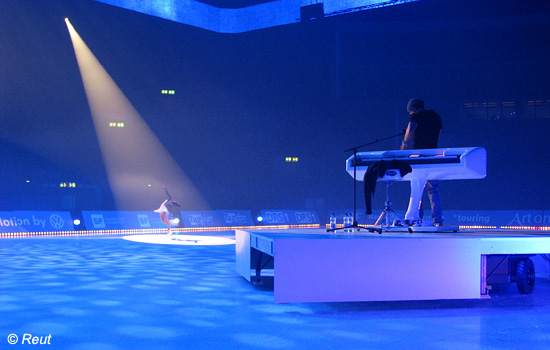
Daniel Powter and Sarah Meier, Art on Ice 2009
And how do you choose this star? In previous years you had Scorpions or even Monserrat Cabalier.
It can be completely different next year. A lot depends on the ideas and the options, on the vision of Oliver Höner, the leader of the production. He has some ideas; he talks to his creative team, and Marvin Smith. We try then to contact some artists we're interested in, so there are a lot of discussions. It also depends if these artists we want are free. But we are not fixed on something, we are very open-minded.
Should it be someone very known in Switzerland specifically?
The guest star is normally someone known worldwide. He has to be known in Switzerland, that's for sure very important, but every world star is known in Switzerland too. We have to find someone known both in Zurich and in Lausanne. Zurich and Lausanne are not so far from each other, it's about two hours drive, but the culture is completely different. So we have to find somebody who is famous in Lausanne as in Zurich.
 And then, after the music is chosen, there is the next challenge - to find the skater to perform to it. The match between the artists, between all forms of art is crucial, emphasises Oliver Höner: "Some shows are trying to use live music but they don't understand that you need specific music to have good figure skating programs. Sometimes they are just choosing something because it's popular and then combine it with some skaters who are not feasible for that type of music. You have to understand which music is going to work for figure skating and which skater can do which number, where to make the intermission. This takes a lot of preparation, a lot of thinking. It's very important that if you do this combination you do it in a clever way. It's a process which takes at least seven-eight months before the show starts."
And then, after the music is chosen, there is the next challenge - to find the skater to perform to it. The match between the artists, between all forms of art is crucial, emphasises Oliver Höner: "Some shows are trying to use live music but they don't understand that you need specific music to have good figure skating programs. Sometimes they are just choosing something because it's popular and then combine it with some skaters who are not feasible for that type of music. You have to understand which music is going to work for figure skating and which skater can do which number, where to make the intermission. This takes a lot of preparation, a lot of thinking. It's very important that if you do this combination you do it in a clever way. It's a process which takes at least seven-eight months before the show starts."
The unique bond of musician on the stage and skater on the ice creates a very special experience for both sides. "It's an experience no one can understand unless you're right there able to almost skate with them. But you don't have to do all the hard moves", says Anastacia who performed in "Art on Ice" two years ago. "To perform and watch somebody skating feels like you give them your power to help them skate. It's a very different kind of energy than an audience and an artist. I'm in love with it! I love it, I love it to death."
Emily Bear, a 10 year old piano prodigy from United States, was invited to play at this year's edition of the show. She accompanied some of the songs on the piano, played her own compositions and even skated a bit, in the finale.
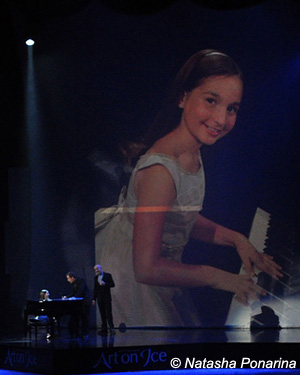 Emily, was it the first skating show you've ever seen? If not what do you think makes "Art on Ice" different from other skating shows?
Emily, was it the first skating show you've ever seen? If not what do you think makes "Art on Ice" different from other skating shows?
I have seen other ice shows live before and my sister is a figure skater. "Art on Ice" is very different from anything I have seen because of the mix of the live music with skaters of such high level. Combining the live music with the skating was very unique and getting to collaborate with the skaters and to see how they would interpret music that I composed was very exciting.
Did you know any of the skaters before you came to Switzerland?
Not personally, but I watched videos of them skating. They are amazing skaters, it was an honour to perform and create with them!
What was it like to play for the skaters? Was it harder than to perform alone? What do you think, who needs to "adjust" when a musician and a skater perform together?
It was amazing to play for the skaters. It is different than performing alone for timing with the choreography. I memorized the skaters' choreography and would watch them as I played so I could shape the song to their moves and work with the skaters to make it flow together. I think the skaters usually have everything timed exactly to the recorded music but I wanted to give them flexibility so if they wanted to take a little more time on a move I would watch them and time my music to make it work for them.
Aljona Savchenko & Robin Szolkowy skated to your music. What do you think about their performance?
"Diversity" was composed for the Dalai Lama who I performed it for last May. 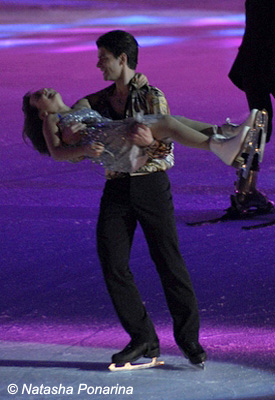 This was the first time it was used for skating and I loved the story Aljona & Robin told with their skating.
This was the first time it was used for skating and I loved the story Aljona & Robin told with their skating.
Name one or two show numbers you loved the most and why.
I loved "Diversity" because it was cool to see how the skaters interpreted my music. I also loved "My Body is a Cage" and working with Stéphane Lambiel! The "Summertime/Mess Around" medley was also fun - and I got to play with Gary Scott & Art on Ice Band!!
You put your skates on at the end of the show. Whose idea was it? And weren't you afraid?
Two weeks before we left for Switzerland we got an email asking if I might want to skate in the finale of the show. I asked my Mom because I hadn't skated since I was 5 years old. Mom said "yes" and I took a couple of lessons with my sister's skating teacher and practised a few times. I was so excited to skate in the finale. My favourite part was when Stéphane Lambiel spun me around on the ice!
When I came to Zurich to see "Art on Ice" for the first time, it obviously was for figure skating. Watching the rehearsals before the premiere I realized that "Art on Ice" is much more than that. I saw how much efforts is put into this show not only skating-wise, how many people, not necessarily from the skating background, are involved in the production. In this article I wanted to meet skating fans with some of those who are behind, to bring into limelight those who work hard to make the miracle happen but most of the time are not seen or overshadowed for us by our favourites on the ice.
